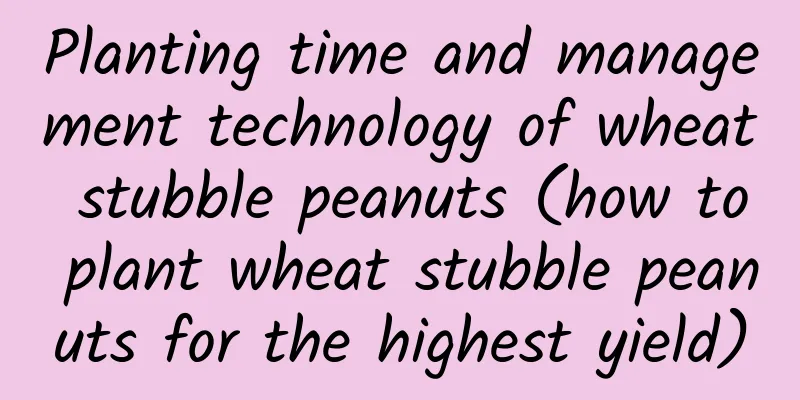Planting time and management technology of wheat stubble peanuts (how to plant wheat stubble peanuts for the highest yield)

|
After harvesting wheat, people usually plant corn, but few people plant peanuts after wheat stubble, also known as summer peanuts. Because summer peanuts have a short growth period and a lower yield than spring peanuts, it is better to plant spring peanuts. To obtain high yield of peanuts in wheat stubble, you need to pay attention to:1. Seek early sowing Here we cannot do it later than June 20th, otherwise the growing period will be shortened and it will be difficult to obtain high yields. 2. Cover the ground with film Some people think that summer peanuts are planted without plastic film because the temperature is high during planting. But this is actually not true. Since the growing period of summer peanuts is short, the temperature is low when the fruit increases in weight and the heat is insufficient. In order to increase the effective accumulated temperature during the growing period and meet its temperature needs for growth, it is important to pay attention to covering the film. Judging from the yield of summer peanuts planted with film covering in the past few years, the yield per mu increased by nearly half compared with that without film covering, reaching more than 600 kilograms, while the yield without film covering was only less than 400 kilograms. 3. Variety selection When growing summer peanuts, you must be careful to select medium- or early-maturing large-fruit varieties or medium-fruit high-yield varieties with strong adaptability. 4. Dwarfing and dense planting Summer-sown peanuts have a short growing period and low yield per plant. To achieve high yields, the sowing density must be increased. However, increasing the sowing density will inevitably lead to field congestion, poor ventilation and light transmission, which can easily cause plants to fall over, so dwarfing measures must be taken. I heard from the older generation that in the past when there were no growth-regulating agents such as paclobutrazol and ethylenediaminetetrachloride, farmers mainly intercropped peanuts in wheat fields or sowed peanuts on flat land after harvesting the wheat without creating ridges. After the peanuts enter the flowering period, combine inter-row cultivation and weeding, and add soil to the base of the peanut plants. The purpose is to shorten the distance that the high-node fruit needles penetrate into the soil, make the fruit needles penetrate into the soil earlier, bear fruit earlier, and create a loose soil environment for the expansion of peanut fruits . At the same time, after the peanuts were cultivated, ridges were formed between the rows, which was conducive to watering and drainage. However, most peanuts are now planted using ridge-building and film-covering methods. In addition, due to labor constraints, no one here builds up the soil for peanuts anymore. Instead, we use paclobutrazol and other drugs to control growth and dwarf the plants, shorten the distance that the fruit needles enter the soil, and prevent lodging. Use growth inhibitors such as paclobutrazol and ethylenediaminetetrachloride, and spray them about a month after the summer peanuts begin to bloom. For example, 15% paclobutrazol is generally added in 10-15 grams per barrel of water, depending on the growth potential of the plants. Compared with spring peanuts, summer peanuts grow faster in the early stage, so their management is different from that of spring peanuts. Water and fertilizer management should be strengthened to promote early growth of seedlings and increase the number of effective flowers. In the middle period, spray paclobutrazol and other growth control agents to ensure that the plants grow steadily and do not fall over. In the later period, pay attention to drainage and irrigation, strengthen foliar fertilization, prevent disease and insect damage, avoid premature aging, promote photosynthesis, promote fruit enlargement, increase seed material bulk density, and increase yield . |
<<: How often should fig pots be watered (potted fig cultivation and management techniques)
>>: What should I do if the new branches of roses grow thin and long?
Recommend
Difference Between Bell Pepper and Green Pepper
1. Shape distinction: 1. Sweet peppers look like ...
How to take care of the newly bought money tree
1. Put it in the sun with appropriate intensity T...
When is the best time to repot the fortune tree?
1. Repotting in spring Generally speaking, the mo...
Can lotus be grown from lotus seeds? How to grow lotus from lotus seeds?
1. Can it be grown from lotus seeds? Lotus seeds ...
The legend of Jacaranda
legend On a street in Dehua, a small mountain cit...
Breeding methods and precautions for blue butterflies
The blue butterfly is very easy to grow. It is a ...
How to plant red spider lily
1. Planting time The best time to plant red spide...
How to plant fresh Dendrobium? Planting techniques and methods
Fresh Dendrobium growth environment requirements ...
Can Japanese Begonia be hydroponically cultivated? Hydroponics cultivation methods and precautions
Can Japanese Begonia be hydroponically cultivated...
What are the plants that bloom in autumn?
Spring brings flowers and autumn brings fruits. Au...
When is the best time to propagate Christmas cactus by cuttings (tips to increase the survival rate of cuttings)
In fact, the best time for Christmas cactus cutti...
Chrysanthemum cutting time and method
Chrysanthemum cutting time Chrysanthemums can be ...
How to grow camellia so that it blooms
1. Ensure lighting Camellia prefers sunlight, so ...
How to water Deutzia
1. Watering during the seedling stage This plant ...
Why does the variegated hosta rot from the roots?
Causes of root rot Loose soil Hosta is suitable f...









